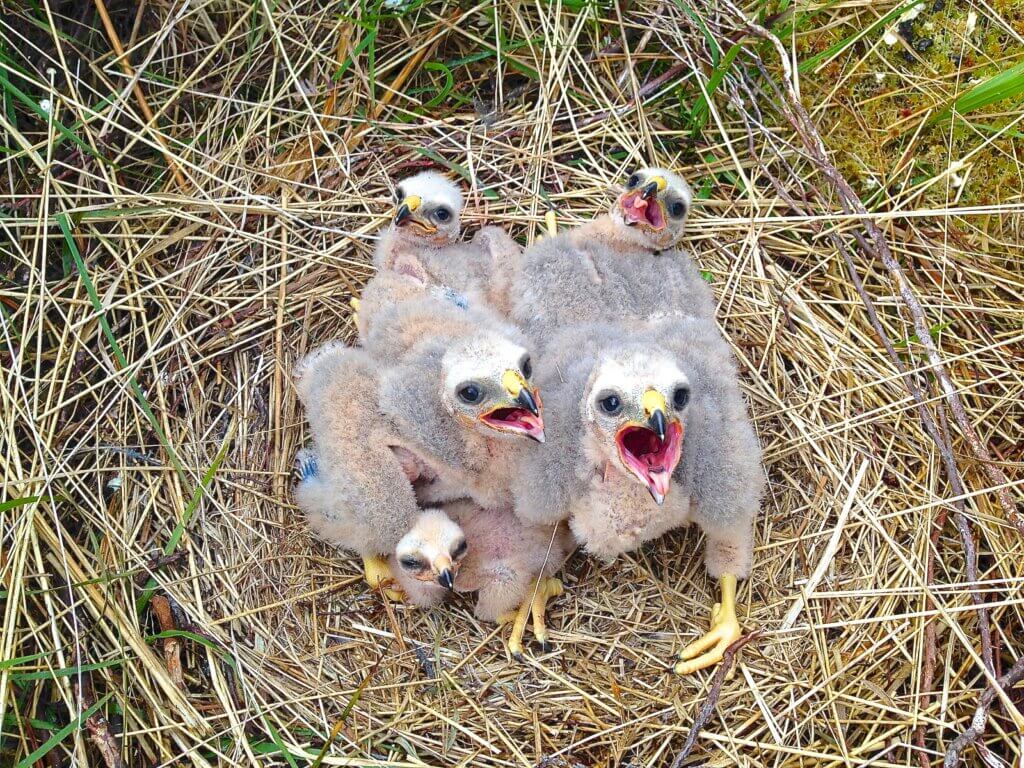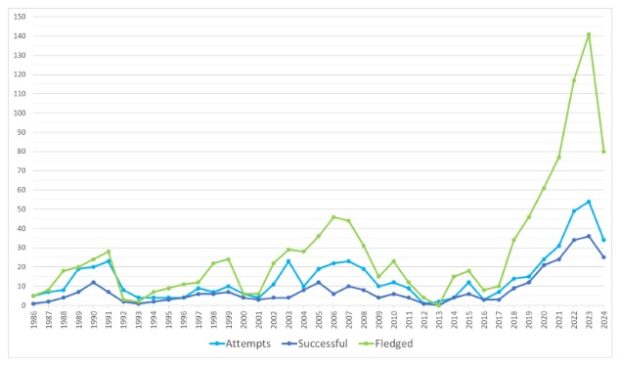
Natural England has published, in more detail than in previous years (click here), the numbers of Hen Harriers nesting in England – they are down this year.

Numbers in 2024 are lower than in 2023 and 2022 and only slightly higher than in 2021.
This year puts an end to a run of years of increasing Hen Harrier numbers in England which have been trumpeted as a success of the ill-considered brood-meddling scheme by moorland managers and Natural England. For a different view on brood meddling ask almost any raptor worker, the RSPB or see this report by Wild Justice, Meddling on the Moors – click here.
Nevertheless, this year’s lower Hen Harrier numbers are significantly higher than in any years of recent decades except the last few years. These numbers, though reduced, would have been regarded as amazing until very recent years. There has been a significant change.

Hen Harrier breeding numbers fluctuate due to a range of factors – and they fluctuate from year to year more than those of most raptors. Back in the olden days of the 1990s, the Langholm Study produced good evidence that Hen Harrier average densities were determined by the densities of small birds (prey for Hen Harriers), especially Meadow Pipits, but that the variation around those numbers from year to year were related to the cycling of vole populations. I haven’t met anyone who has said that this year was a good vole year and so we would expect fewer Hen Harriers to attempt to nest. I wonder whether Short-eared Owl numbers are down too, as they are even more dependent on vole numbers.
The weather, the year to year manifestation of the climate, is also important. This spring was an awful spring in most parts of the UK including the uplands. Lots of rain is one of the factors that has probably affected Red Grouse numbers, which have been so low that many grouse moors have had yet another poor year of shooting, and that weather, and to some extent lack of Red Grouse, will have affected Hen Harrier numbers too. I have made the point every time a periodic national survey of Hen Harriers is carried out that this bird has good years and bad years (vole- and weather-related) due to ‘natural factors’ and the national numbers will reflect the vicissitudes of the year as well as the overall quality of the habitat and also, very importantly for this species, the level of illegal persecution.
We can be fairly sure that this year’s lower English breeding numbers of Hen Harriers is due to awful spring weather. As a consequence of overall low numbers there will have been few Hen Harrier nests that will have qualified for the brood-meddling scheme where chicks (or eggs according to the original project plan, but it has always been chicks) are removed from qualifying nests, raised in captivity, and then released on the moors. This project is a prize for grouse moor managers, within whose number are to be found those who illegally kill this protected bird, as they get through a licence the impact they would otherwise seek to create through wildlife crime, of fewer active Hen Harrier nests on their grouse moors. But to be a qualifying nest, there has to be another active Hen Harrier nest in the general vicinity. Inspection of the NE table of nesting numbers shows that there won’t have been many places where there were qualifying nests. Interestingly, the populations held up better in Bowland (where almost all, usually all) Hen Harrier nests are off commercial grouse moors and are on United Utilities land (which despite being a water company (boo! hiss!) has taken a good line on brood-meddling, ie they don’t do it) and in Northumberland where a group of organisations including Forestry England, RSPB and the Northumberland National Park have protected nests and in at least some years have provided supplementary food for nesting Hen Harriers. I wonder what happened this year.
Of course, no-one believes that grouse moor managers love Hen Harriers and so in a year when Red Grouse numbers are very low there is no incentive to be ‘nice’ to Hen Harriers (by getting them shipped off your grouse moor!).
There was no brood meddling on grouse moors this year, and that must be because the weather was awful and there were few qualifying nests, but it is also interesting that English Hen Harrier numbers held up in those areas where no brood meddling has happened. NE are thinking about whether they will license Hen Harrier brood meddling in future – they should decide not to as Hen Harrier persecution remains rampant on English grouse moors, eg see here.
The NE blog on numbers is more detailed than usual – that is to be welcomed and we should have seen data of this type for many years but NE has been secretive about almost every aspect of their Hen Harrier work until shamed into being a little more open by the likes of the excellent Raptor Persecution UK blog and this blog.
Can we expect a statement from the RSPB on these findings – I hope so. I haven’t seen anything from the shooting community yet, and we know they aren’t out shooting Red Grouse.
[registration_form]
The Bowland and Northumberland figures make me very suspicious of the apparent decline in other ( mainly grouse moors) areas. Yes it may have been a bad season for both Red Grouse and Hen Harriers. However with MA members essentially withdrawing from the Brood Meddling “experiment” presumably because the “new” conditions they wanted were not met one wonders how many harrier pairs were dealt with in the old illegal way. Even an FOI request of NE may not discover that, although I have made one. Also couple this with the increasing numbers of satellite tagged birds that have ” disappeared” since the last breeding season. What is quite, quite clear is that given the uncompromisingly awful utterances of “kill truth” Gilruth for the MA that the shooting lobby is as ever completely unrepentant ( or heads in the sand or their own fundaments) and utterly untrustworthy.